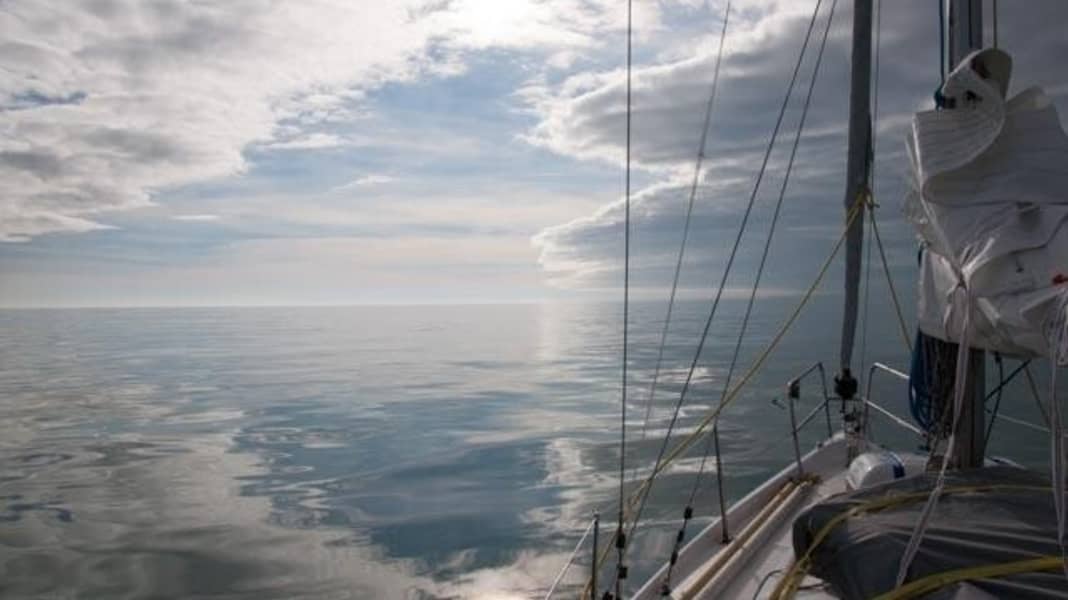
There's a glass of cranberry juice on the table next to me. Open. Without a lid, without a gimbal. I've been leaving it there for days. It's not because we're travelling on a catamaran or because the glass is firmly "sikaflext" to the tabletop. No, it's because the Atlantic is just lying there calmly, like a village pond on a windless summer's day. Leaden and heavy.
We've been travelling across the Atlantic for six days now, and for five days we've been stuck in a large area of high pressure, a Bermuda high. What we already suspected was confirmed yesterday when we received a weather map on shortwave radio. We couldn't make out much because the reception was pretty poor, but when our sea area beeped through the airwaves, the image briefly became clear and showed a large "H", in the centre of which we are currently located. At least we're halfway there. We are halfway through.
Whilst we've somehow managed to run 80s the last few days (partly by running the engine for a few hours every day to get out of the stationary system ... ), yesterday nothing worked at all. Absolutely no wind. I was on the verge of hoisting the sails and putting the anchor light on overnight instead of the tricolour lantern. Maybe even drop anchor. Oh, if only I could draw caricatures like Mike Peyton. It would be a great picture of us lying here. In the middle of the Atlantic, with the anchor dangling 70 metres below the boat at the end of the chain.
Years ago, I was actually asked a few times whether we always drop anchor at night in the middle of the Atlantic. After dismissing the question a few times with "no, that's too deep", I was interested in doing the maths.
Here below us, the water is more than 5000 metres deep. If we were to drop anchor every evening and put in the necessary but absolute minimum amount of chain (three times the water depth), that would be 15,000 metres of chain. I remember that the package with our anchor chain weighed about 90 kilos, one metre of our 8-millimetre chain about 1.3 kilos. So we should be able to stow 19.5 tonnes of chain. If possible, of course, without making the ship bow-heavy. We ignore the fact that the chain for such a large ship would have to be much thicker and heavier than ours, which is designed for a 33-foot ship.
With its 1000 watts, our anchor winch is already very powerful for a boat of this size and can haul in around 30 metres of chain per minute. It would take 650 minutes - or almost 11 hours - to haul in the whole anchor chain. We would therefore have to start hauling in after midnight in order to be able to set sail again after a very late breakfast. Again, we ignore the fact that the Wisch already reaches its limits with a towing load of 550 kilos and draws around 90 amps. Even with the Sterling charge booster, the engine's alternator only delivers 55 amps. Even if it could supply the anchor windlass continuously, we would burn up around 16.5 litres of diesel per mooring manoeuvre and would only be able to anchor nine times before our diesel supplies ran out.
Some readers might get the impression that all the sun here on the Atlantic could be damaging our minds (no doubt!) or that the vastness and boredom are slowly turning me into a maths nerd ... But there really isn't much else to do at the moment apart from lie in the shade, read and wait for the wind.
But there is a lot going on around us. Three large barracudas are circling the boat and a few small fish are lying in the shade under our hull. They are feeding on our kitchen waste (potato peelings, etc.). There are also lots of Portuguese galleys drifting past us.
When we left the engine running for three hours yesterday (hoping to get a few miles out of the high), Cati shouts: "Look, there's something in the water. Something big!" Two long black areas directly in front of the bow. Before I can even say "Looks like two whales", two fountains of water blow up in front of us. "Change course!" Cati is terrified of whales because she has heard many stories of other sailors who have collided with whales. Ten years ago, I myself saw a Swedish Najad lying in St Lucia with its skeg missing - it had broken off and the shaft was hanging out of the hull in an S-shape. A shipyard worker told me what happened: "The ship sailed between a whale and its young while crossing the Atlantic. The mother hit the yacht." Since then, we have always marvelled at the animals from a distance.
We still have 2200 nautical miles to the Azores ahead of us and have only managed 520 miles. Today we had our negative record of only 53 miles in 24 hours. But the wind should return by Saturday at the latest. Until then, we'll keep tugging at the sails and trying to get as much speed out of the boat as possible. But we also enjoy the peace and quiet and the endless blue around us. And make the most of the forced break. Last night, for example, we had an original German bratwurst in the middle of the Atlantic, thanks to Aldi in West Palm Beach and a good fridge. The doldrums were briefly forgotten, and to our delight a light wind came up as darkness fell, so that the wind steering system pushed us through the night at 2.5 knots. After the doldrums of the previous week, it was a really exhilarating ride ...
You can follow our tracker with the daily positions at www.zu-zweit-auf-see.de.

